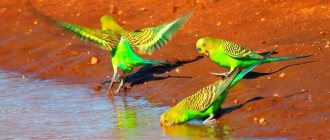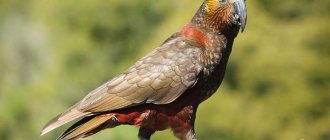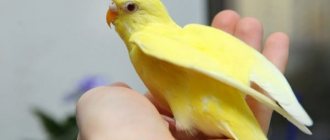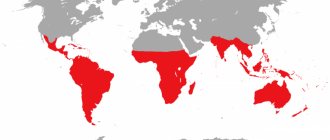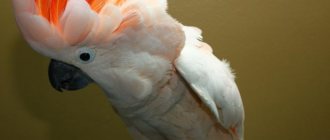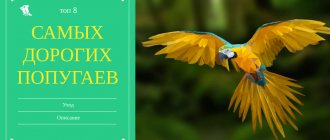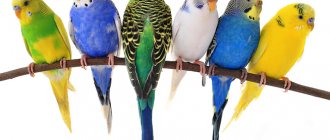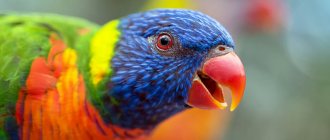Author: Winner56
April 25, 2021 11:57
Tags: parrots birds
7725
10
Bright plumage, interesting habits and the ability to copy human speech have made parrots one of the most beloved pets. Together with representatives from the corvid family, or ravens, parrots are considered the most intelligent birds living on Earth. Parrots are very sociable, cannot stand loneliness and get along well with people.
0
See all photos in the gallery
From the huge number of different birds that live on our planet, you can always single out one representative who can be recognized immediately. And in fact, there is not a single person who would not recognize a parrot at first sight. Today there are approximately 300 species of parrots, but today we will talk about the largest of them.
Noble green parrot
These parrots are known for their affectionate behavior, enthusiasm and remarkable intelligence. Surprisingly, some of them can correctly imitate many sounds, especially human speech.
Because of these features, they have been kept in cages since ancient times as beloved pets. Their diet consists of seeds, fruits, nectar, arthropods and other small insects.
Scientific studies of their language have proven that green parrots have intelligence. In addition to this, they are skilled at solving puzzles.
Most popular types
Nestor-kaka
These birds got their name from the characteristic “ka-ka” calls that sound loudly in the beech forests of New Zealand. Parrots are not distinguished by their bright colors, but despite this, they still remain very cute, interesting and affectionate pets. The body length of nestors is about 45 cm, weight reaches 550 grams. The color of the feathers is dark brown with black edging and an olive tint. The head is gray with a red band at the back of the head. Cheeks in yellow-orange tones. The beak is large, hooked and curved.
Nestor-kaka parrot
Representatives of the species have a special brush on the tongue, like a loris, which allows them to drink nectar from flowers. The diet also consists of berries, fruits, seeds of herbaceous plants and small invertebrate animals. Kaka is now endangered. It is rare in captivity, although it is unpretentious and feels good as a pet.
Budgerigars
popular birds for keeping in captivity. The number of domestic parrots is many times greater than the number of their wild relatives. Breeders have bred about a hundred variations, differing in color, presence of crest or size. The color is usually bright, often monochromatic, with black stripes on the head and wings.
Budgerigars
Body size is about 17 cm. The tail is long, straight, pointed at the end. Above the beak there is a cere of contrasting color. The character is friendly, cheerful, mischievous. The birds are well trained, easy to care for, and some can repeat up to 600 words.
Greater yellow-crested cockatoo
One of the most beautiful parrots in the world. Lives in Australia, on the islands of New Guinea, Tasmania and Kangaroo. The size of an adult is 50-55 cm. The body color is snow-white, the inner feathers of the tail and wings have a yellowish tint. The bird's head is decorated with a sunny yellow crest. The beak is large, black-gray, curved downwards.
Beautiful yellow-crested cockatoo
In captivity it is found quite often, especially in circuses and zoos. As a pet, he is very loyal, affectionate, and amenable to training. But it requires a lot of attention. If it is deficient, it screams loudly and can bite painfully.
Read also
Greater yellow-crested cockatoo
Arantiga Yandaya
They inhabit the forests of Guiana and eastern Brazil. The main color tone is golden yellow. The flight feathers are colored deep blue, and the bird's tail is green. The beak is beige with a pinkish tint.
A peculiarity of Aratinga Yandaya is considered to be the deep attachment of parrots of one pair to each other. They form alliances for life and never separate for almost a second. In captivity, pets successfully reproduce when kept in an enclosure.
Arantiga Yandaya
Rock (Patagonian) parrot
The bird lives in deserted mountain forests and rocks of Uruguay, Chile, and Argentina. Plumage in olive-brown and dark green tones. The abdomen is bright yellow with a red spot in the middle. The periorbital ring is white, slightly elongated in the horizontal direction.
In captivity, they quickly become tamed, become strongly attached to humans, and can speak a few words.
Broad-tailed loris
Beautiful birds with bright plumage in red and blue colors. The wings are grassy green. There is a black cap on the head, the back of the neck is the same shade. The undertail and “panties” are bright blue. Body length 30-31 cm.
Broad-tailed loris
In nature, they inhabit the forests of New Guinea or adjacent islands. In captivity they are quite loud, but they can remember a large number of words and are trainable.
Bronze-winged Parrot
Habitat: northeast Peru, Colombia, Ecuador. The plumage is black with a bluish tint. The upper back and shoulders are dark brown. The rump, tail, and flight feathers are dark blue. The wings are brown with a light edge. The undertail is in red-violet tones. The beak is lemon yellow.
Bronze-winged Parrot
They are very sociable, social creatures. As pets, they quickly become tame, love to play with various objects, fly around the room, and learn something new.
Yellow-cheeked rosella
Bright and the smallest of its kind. The body size does not exceed 28 cm. The color is variegated on the back. The throat, neck, undertail, belly and head are deep red. The edges of the wings have a deep blue tint. The birds' cheeks are lemon yellow. Females in more restrained colors.
Yellow-cheeked rosella
The natural habitat is considered to be forests and parks of the southwestern coast of Australia and adjacent islands. In captivity, it is quickly tamed and has a peaceful, kind, calm character. These parrots are very musical, they can whistle beautiful melodies and remember one or two small phrases.
Solar aratinga
Its habitat includes Venezuela, Guiana and the northern regions of Brazil. The subspecies is considered the most beautiful ornamental bird for home keeping. The color is very bright. Most of the body has a rich yellow cover. The wings are painted in dark blue tones with a greenish edging of some of the feathers. The tail of the aratinga is emerald in color, and its tip has a bluish tint. The beak and iris are brown.
Beautiful sunny aratinga
The solar aratea is the most popular representative of the species among bird lovers. It is perfectly tamed and reproduces when kept in pairs.
fan parrot
Distributed in forests near the Amazon River and in northern Bolivia. A distinctive feature of the bird is a movable collar of red feathers with a bluish edge, giving it a regal, stately appearance. The chest is in the same colors, but less bright. The wings and back are rich green. The head is brown with a whitish tint. In combination with a hooked beak, it resembles a hawk. The length of the parrot is about 35 cm, the tail is short, straight-cut.
Beautiful fan parrot
At home, the pet has a calm, friendly character. But still rare among amateurs. Probably due to the high price.
Multicolored lorikeet
These bright and incredibly colorful birds live in the mountain forests of Australia, New Guinea and the adjacent islands. The body length of the birds is 27-30 cm. The head and abdomen are blue-violet, the breast is fiery red with an orange tint, the back, wings and tail are green. The beak is scarlet.
Multi-colored lorikeet
They are well tamed in captivity. The basis of the diet is the seeds of various herbs. Be sure to treat your pets to apples, berries, citrus fruits and herbs. When bred at home, they can produce offspring.
Corella
Widely distributed among pet lovers. The genus is represented by only one bird species. Cockatiels are distinguished by a sharp crest on their head and a bright red “blush” on their cheeks. The color range is quite modest; breeders have bred birds in gray, beige, and white tones.
One of the beautiful cockatiels
Nymph parrots (as they are also called) are easy to care for and can be trained. They can repeat a few words, whistle beautiful melodies, and imitate a variety of sounds well.
Helmeted Cockatoo
Birds have an extraordinary appearance. Wide, light feathers puff up funny on the head in the form of a crest or crown. The main color is grey. Males have a red mask and a comb of the same color. There is a white edging along the edges of the feathers, which is why the bird appears to be covered with scales. Body length is about 35 cm.
It is difficult for them to adapt to life in captivity and often suffer from self-plucking or stress molting.
Helmeted cockatoos
Parakeet
Long-tailed parrots differ from other varieties of parrots in their slender build, small size and long tapering tail. They are popular pets in India. Their name comes from the French word perroquet, which is French for parrot.
They lay an average of 3-8 eggs, and in a flock they reproduce very successfully, because the flock encourages a couple who decides to have chicks.
Helmeted Cockatoo
Another beautiful parrot is the helmeted cockatoo. Living up to its name, this cockatoo has an unusual appearance that appears to have a helmet instead of the top of its head. It's all because of the narrow crest curved towards the beak, painted, like the whole head, in a bright red color. The rest of the parrot's feathers are gray and each has a white edge. The beak is beige.
The helmeted cockatoo is common in the tropical forests of Australia, but as a pet it is quite rare.
Lorikeet
This short-tailed, talking, unusually colorful parrot lives in Australia and New Guinea. It feeds on pollen and nectar. To collect food, such as small insects, lorikeets use their furry tongues, which are like small brushes.
Multicolored lorikeets are the most showy of this group. Crowned musk lorikeets also have an interesting coloration.
Multicolored lorikeet
The multicolored lorikeet is common in zoos in Europe, but is rarely seen as a pet, because The lorikeet requires special nutrition. The parrot cannot eat grain feed like most other parrot species. In the wild, the multicolored lorikeet feeds on pollen.
The head and abdomen of the lorikeet are blue. The breast is red with a yellow tint. The wings and tail are dark green, and the undertail is light green. The length of the parrot does not exceed 30 cm, the weight is usually 150 grams.
Corella
A small, gray, crested Australian parrot with a red patch around the ears, a yellow head and a heavy beak for cracking nuts is called a cockatiel. These birds rank second in popularity among poultry. Their characteristic crest gives cockatiels a special charm.
There are currently 22 color mutations in parrots in the world. Corellas are native to the arid regions of Australia. Its lifespan in captivity is usually 16-25 years.
Wavy
Wild budgies live in Australia. But the number of birds in captivity is much greater than in nature. And all because they are incredibly charming, funny and beautiful.
It’s not difficult to guess why they are called “wavy”: the back of their head and upper back are covered with a dark wavy pattern.
The main color of parrots is grass-green. In nature, birds of a different color could not survive, but parrots of different colors have long been bred in captivity: yellow birds appeared in 1872, blue birds in 1878, and white birds in 1917. Now there are even more of these colors, so in the pet store budgerigars look like a rainbow-colored chirping cloud, and some of the birds amaze with the variety of colors and shades.
Eagle parrot
There are many species of parrots, and the eagle or, as it is also called, the bristle-headed parrot is one of them. It is a black parrot the size of a crow with a short tail. Adults can reach 50 cm in length.
Its underparts are red and its legs are grey. The back of its head does not have enough feathers, and the feathers on its neck are bristly, which is why it is called the bristlehead. Eagle parrots love to fly in pairs or small flocks.
It can be found in lowland forests such as peat bogs and swamps, mangroves, etc. This type of parrot mainly feeds on vegetables, fruits, small plants, etc. Eagle parrots are one of the least studied parrots.
Green-winged macaw
The Green-winged Macaw is a beautiful parrot that surpasses any other species in popularity. The macaw is intelligent; its brain size can be compared to that of a two-year-old child. The parrot learns quickly and can memorize a large number of words. A special feature of the macaw is that it can independently compose phrases from words it knows. But a wayward character is also considered a distinctive feature. The parrot can be stubborn and only do what it likes, which is why the macaw is difficult to train.
The green-winged macaw acquired the status of the most beautiful parrot because of its tricolor color. The head and abdomen are bright red. The wings are painted in three colors: the upper part is red, in the middle there is a narrow stripe of green, the lower part is light blue feathers. The tail also has a stepped color pattern of red and dark blue.
Budgerigar
The budgerigar is a species of parakeet whose name has controversial origins. They are green and yellow with black jagged spots on the nape, back and wing.
Due to their low cost, small size and ability to imitate the human voice, they are very popular all over the world. Budgerigars are considered the third most popular pet after dogs and cats.
Yellow-cheeked rosella
The yellow-cheeked rosella is native to Australia. It has a bright color that is different from others. The flight feathers are colored blue. The crown and abdomen are red. The cheeks, true to their name, are pale yellow in color. The back and upper part of the wings change from green-black to yellow. The tail is colored turquoise-red. The length of the parrot is less than that of other subspecies of rosella: no more than 20 cm.
Yellow-cheeked rosellas are famous for their calm nature and friendliness. They easily get along with other parrots in the same cage. Unpretentious to keep at home.
Cockatoo
This species of parrot is found in New Guinea, the Solomon Islands and Australia. Some are black, but most are white with yellow or red tinges. With the help of their powerful beak, these birds are able to crack nuts, and a strong tongue helps in feeding. Cockatoos also feed on fruit tree shoots, grass and insects.
This resourceful, affectionate and burrow-nesting parrot can live over 50 years and is kept in a cage as a pet. Its forward-curved feathers are golden and narrow.
Inca cockatoo
The Inca cockatoo or Major Mitchell's cockatoo has an unusual soft pink feather color, subtly reminiscent of pink cotton candy, and a pale red beak. A distinctive feature of this type of parrot is its long crest, colored white and red. The length of the Inca cockatoo varies from 45 to 55 cm.
The Inca cockatoo has a hard time getting used to people. However, if you managed to tame a parrot, then be prepared to devote a lot of time to it. From lack of attention, the Inca cockatoo can begin to pluck itself.
Macaw
The macaw is a long-tailed, brightly colored bird. The male and female of this parrot species look identical. They cannot stand loneliness, so they fly in pairs or flocks. With the help of their sickle-shaped beak and muscular tongue, they can feed on hard nuts, seeds, fruits, flowers, etc.
Easily tamed, Macaws usually nest in river burrows and tree hollows. They can often imitate sounds. In addition, in captivity they can live up to 65 years.
The popularity of these parrots has led to their inclusion in the list of endangered animals.
Banks' mourning cockatoo
This is a very beautiful parrot, which was named after the English naturalist Sir Joseph Banks. The predominant color of the plumage of birds is black.
Among the main qualities of a parrot it is worth highlighting:
- in males the plumage is black and has a bright shine. There is a red stripe on the surface of the tail;
- in females, the plumage is also black, but it has a characteristic brown tint. On the abdomen, head, wings, neck, and tail there are inclusions of a pale yellow color;
- a lush movable crest is provided on the surface of the head;
- birds have a massive beak. In males it is dark gray in color, and in females it is light gray.
Rosella
Rosella is a broad-tailed, colorful parrot that is quite famous among poultry lovers. The usual diet is fruits and seeds. Its characteristic features are cheek spots and green plumage, which is often found on both females and males.
Rosella lives in forests. These parrots are native to Australia. Rosella loves to swim in puddles and scratch its head with its paws, which are located behind its wing.
Tell your amazing story
GET 500 rubles
Alexander's ringed parrot
These are cute parrots that prefer to live in the upper tier of the tropical forest. They build nests there, feed and breed offspring, and rarely descend to the ground. Birds live in southeast Asia.
The main features of parrots include:
- representatives have an unusual plumage color - it has a grassy green color;
- the crown area has a blue tint;
- there is a brown spot on the shoulder blades;
- there is a black stripe on the frontal part;
- Males are provided with a beautiful necklace. It is colored pink in the upper part of the neck, and black on the sides and lower part of the beak; from the outside, this part looks like a tie.
Aratinga
Although Aratinga parrots have been described in many scientific journals, they are mainly used in aviculture. Aratingas are medium-sized parrots. They prefer to consume fresh products: granular mixtures and seed mixtures. What they definitely shouldn't consume is alcohol, chocolate, fatty/oily foods, etc.
Aratingas have a penchant for the arts: singing and painting. This makes them strikingly different from other parrots.
fan parrot
This is a very beautiful parrot that lives in South America. Representatives of this breed have a bright appearance; they have unusual plumage with an emerald color. But the back of the head and neck are painted ruby. The chest area is dark ruby in color, and the border is pale blue.
Adult birds have the following parameters:
- body length size is 36 cm;
- the tail does not exceed 17 cm in length;
- The parrot's weight is no more than 280-290 grams.
In nature, there are two types of fan parrots:
- nominal. He has a light tint to the frontal part. It is widespread among bird breeders;
- Brazilian fan. The coloring of the frontal part is dark. This is a very rare bird species. The parrot was brought to Europe in the 1980s by mistake. It is very similar to its counterparts of the denomination type, so it was mixed up at customs when imported.
Laurie
Lorises belong to the parrot family (Psittacidae) and the subfamily Loriidae (Loriinae). Lorises are small to medium-sized parrots that are distinguished by their brush-like tongue. With its help, they feed on fruit pulp.
Laurie famously appeared in the third chapter of Alice's Adventures in Wonderland, where Alice argues with a parrot about her age.
Proper care for beauties
The nuances of caring for parrots may differ among different species. However, there are a number of rules that are the same for everyone:
- The bird's diet should be varied. It definitely includes fresh fruits, vegetables, and herbs. Grain food is the basis of the parrot's diet, but usually does not exceed half of the food volume. Be sure to give your pet a mineral supplement - sepia, chalk or a special mixture.
- Cleanliness is the key to your pet’s health. The cage is cleaned regularly; all items are disinfected at least once a month. The bedding is changed daily. Food and drink are renewed twice a day.
- Parrots love to swim. It is imperative to provide them with this opportunity. You can install a bathing suit inside the cage, periodically place it, or spray your little friend with a spray bottle.
- Flight is an integral part of the life of birds. When keeping a pet in a cage, it is necessary to let it out for at least a 40-minute walk around the room every day. A sedentary lifestyle negatively affects the health and longevity of birds.
- For all exotic animals, maintaining indoor climatic conditions is extremely important. Temperature, air humidity, illumination must correspond to the recommended values for this particular species.
- Parrots have high intelligence and lead a gregarious lifestyle. Therefore, they need communication, development and education. Give your pet enough attention, especially if he is kept alone. Study at the same time every day for 15-60 minutes.
- The cage must match the size of the bird and have the necessary equipment: feeders, drinking bowls, perches, toys.
- Monitor the behavior and health of your feathered friend. At the first signs of illness, immediately contact an ornithologist.
National Geographic Australia Country of Parrots documentary film 2015
Compliance with these recommendations will help preserve the bird's natural beauty and longevity. No special plumage care is required; parrots are very clean and do an excellent job of maintaining a neat appearance.
Lovebirds
There are a huge number of species of parrots in the world, but among all of them we are most attracted to lovebirds, which cannot live without a mate. They are so adorable that everyone loves them.
They are known for their adorable colors and affection. These birds remain faithful to their other half until the end of their lives. For this reason they are called lovebirds.
They nest in tree hollows. Despite their popularity, they are difficult to tame, but they can be trained to perform various tricks and imitate human speech. Possessing a very harsh voice, they are quite warlike towards other birds.
Solar aratinga
Representatives of the Solar Aratinga breed are endowed with a unique appearance; this is a very beautiful parrot that cannot be compared with other birds. The bird is a South American species that lives in southern Venezuela.
The main features of the bird include:
- parrots have bright lemon-colored plumage;
- their abdomen is bright yellow with a smooth transition to an orange tint;
- the bird's head has orange plumage;
- The average body length is 28 cm;
- the weight of an adult does not exceed 125 grams;
- It is difficult and impossible to distinguish gender by appearance;
- On average, parrots live from 26 to 30 years.
Nestor-kaka
Parrots of this species are endangered. Nestor-kaka gather in flocks and lead an arboreal lifestyle. They also often fly through the valleys. It feeds on berries, fruits, flowers, plants, invertebrates, etc.
Hollow trees and house roofs are its nesting sites. It is a social bird that interacts with humans. In addition, kaka can lay 2-4 eggs in late winter. Both parents - male and female - help in feeding the young chicks.
Description
Representatives of the order are united by a number of similar features: a strongly curved, strong beak, a dense physique, short legs and the ability to onomatopoeize. Most are brightly colored, often in green tones, which helps the bird hide from predators.
Description of the most beautiful parrots
The sexual dimorphism of many parrots is weakly expressed; females are practically no different in color from males. Pairs are created, as a rule, for life. The diet in the wild consists of fruits, seeds of herbaceous plants, berries, buds, flowers, and sometimes small invertebrates and insects.
Most species adapt well to captivity conditions. Having high intellectual abilities, parrots are very interesting for keeping at home; they can learn various commands, tricks and reproduce words of human speech.
In addition to their sharp mind, the advantage of these birds is also their amazing beauty. The pet will definitely not leave guests indifferent and will decorate any room or garden.
Kea
The world's only mountain parrot, Kea, has an olive green coloring. These birds have a beautiful bright orange color under their wings and a grey-brown upper beak. Keas are omnivores. They eat leaves, insects, drink nectar, etc.
These are very smart parrots. To get food, they can solve logic puzzles (for example, moving a thing from one place to another). The circus is the real calling of Kea parrots. They are rightly called the “clown of the mountains.”
Rock (Patagonian) parrot
This is the most beautiful parrot in the world and lives in Chile, Argentina, and the southern part of Uruguay. Birds prefer to live in empty places without people.
The main characteristic qualities of parrots of this breed include:
- the body has beautiful plumage, olive-brown in color with a hint of brown;
- the wings and head also have an olive-brown color, but their tint is greenish;
- the main color of the abdomen is yellow, there is a red spot in the center;
- the chest and throat area is grayish-brown;
- Males have some distinctive qualities - they have a larger head, a massive beak and a brighter red-orange belly.
Amazon
Like most parrots, Amazon parrots are characterized by their green color that covers all the edges of their body, as well as the red color that appears on their foreheads.
Like all tropical parrots, the Amazon has a strong personality and needs a lot of attention.
Among all birds, parrots are undoubtedly the most attractive, and thanks to their developed speech apparatus they are very close to people, although they only imitate the sounds they hear.
The most beautiful parrots in the world described above are the most famous to people. We may think we know enough about these birds, but if we think about it, we don't know that much. However, it is known for sure that when a person chooses poultry, most people choose parrots.
Alexandrian parrot
The Alexandrian parrot was named after Alexander the Great. It has predominantly grass-green feather color. The beak has a narrow black stripe, and there is also a narrow black necklace under the beak. There are small red spots on the wing feathers. The Alexandrine parrot has a fairly large plum-colored beak.
The Alexandrine parrot not only has a talent for onomatopoeia, but also loves to talk. The parrot quickly gets used to people, making it easy to train with him. It is worth keeping an Alexandrian parrot in a cage with a strong and reliable lock that cannot be succumbed to by a large beak.
What you need to know before bringing such a parrot home
The parrots mentioned above are a delight to watch, but they are hardly suitable for beginners.
Experienced poultry farmers who want to acquire exotic birds should remember the following nuances:
- Tendency to diseases (even with ideal care, it is almost impossible to protect a pet from illness, and in the case of large birds it is even more so; besides, treating a large parrot will cost many times more).
- Arranging a place to live (birds need large enclosures, creating a comfortable microclimate, walking areas).
- Organization of proper nutrition (large parrots eat a lot, and some species find it difficult to choose a diet close to the natural diet that would fully ensure normal life activities).
- The financial component (the cost of the parrot itself, as well as material investments for the arrangement of enclosures and ongoing care).
Therefore, before you get an exotic feathered pet at home, you should weigh all your options and think about the correctness of such a decision.
Every animal or bird requires a lot of attention and care from humans, because, as you know, we are responsible for those we have tamed. But you also need to understand that the larger and more exotic the pet is, the more effort and time it will take to care for it.
Hermit loris
This handsome guy can rarely be found in a home zoo due to certain difficulties in caring for it. But, once in a person’s house, the loris quickly becomes attached to its owners due to its easy-going nature. The bird is very noisy, which it never misses a chance to boast about, but it is precisely this trait that allows it to easily learn to speak. Only the most patient bird lovers can endure such piercing creaking sounds.
The hermit loris, unlike many of its relatives, has rather unusual food preferences: in addition to fruits common to parrots, this bird loves nectar and pollen. While obtaining a sweet delicacy, the feathered baby mercilessly bites into the flower, becoming covered in pollen from head to paws.
Bronze-winged Parrot
A cheerful and playful bird with bronze wings will instantly show opposite traits, barely feeling a hint of competition. Her jealous attitude does not allow her to get along with other exotic birds, which should be taken into account by those wishing to place this pretty creature in their home.
The bronze-winged parrot very quickly becomes attached to its owner and has difficulty surviving separations, and when it sees a threat to one of the family members, it can show courage and fight back against the alleged offender. It is not uncommon for a bird to attack other pets in a fit of anger.
